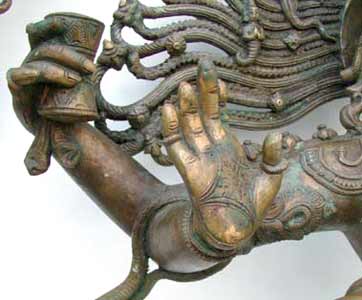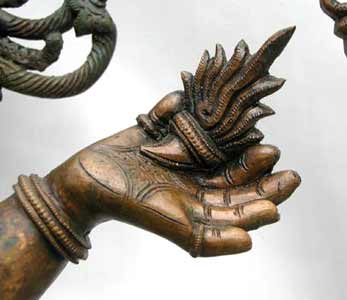A while ago I was asked to blog about Joseph Campbell, and
after months of not knowing how, here it finally is. It’s hard for me to try to
condense what I understand and love about Joseph Campbell into a few ideas.
I’ve been watching The Power of Myth ever since college, after I read The
Hero with a Thousand Faces (I still have the book I “borrowed’’ from my
mom), when I saw it on TV and decided I had to buy it. I once described it as food
for the soul. So for one, it resonates with me. For another, it deals with the
human experience (as all myths do) and so it is universal and un-specific, and
thus it is hard to specify. But anyway, it’s difficult to sum up what Joseph
Campbell means to me... but this blog wasn’t created for summations that distill
great meaning into digestible portions of meaninglessness, so I will do what I
can. To not do that.
After watching the last episode of The Power of Myth, “The
Masks of Eternity,” and writing down everything awesome (which filled nearly
three pages), I am resisting the urge to quote the entire thing. But I think there
is one part where Joe explains a statue of the Hindu god Shiva which
encompasses most of the main themes he talks about.
“The dance of the world – the dancer whose dance is the Universe. In this hand he has the drum of time, which shuts out eternity, and we are enclosed in that; and in this hand a flame which burns away the veil of time and opens us up to eternity; and in his hair is a skull and a new moon, the death and rebirth at the same moment, the moment of becoming.... The goal of your quest in your life is to find that burning point in yourself, that becoming thing in yourself, which is fearless, and desireless, but just becoming.”
 Drum of time: The
beat of the drum symbolizes time and shuts out eternity, which is timeless. Thought
is temporal. Symbols are expressions of thought. The great mystery transcends
thinking and symbols. “God is a thought – God is an idea – but its reference is
to something that transcends all thinking. It is beyond being! Beyond the
category of being and non-being! Is he or is he not? Neither is or is not.” So
the idea of God that most people have is a symbol of the eternal, but it is not
the eternal. Everything that exists, exists in the field of time, and things
like unicorns merely do not exist, but the eternal refers to the transcendence
of such dualities and is not then, or
there, but in the ever-changing moment.
Drum of time: The
beat of the drum symbolizes time and shuts out eternity, which is timeless. Thought
is temporal. Symbols are expressions of thought. The great mystery transcends
thinking and symbols. “God is a thought – God is an idea – but its reference is
to something that transcends all thinking. It is beyond being! Beyond the
category of being and non-being! Is he or is he not? Neither is or is not.” So
the idea of God that most people have is a symbol of the eternal, but it is not
the eternal. Everything that exists, exists in the field of time, and things
like unicorns merely do not exist, but the eternal refers to the transcendence
of such dualities and is not then, or
there, but in the ever-changing moment. Flame of eternity: The
flame which burns away the veil of time opens us up to eternity. It is a
cleansing fire. To be open to what is instead of what you desire or what you
fear is also to give up your ego and your identification of self with your
thoughts. You are not your thoughts, and you are not your fears. This is the
experience of the sublime, which opens you, but which may be terrifying,
detaching you from what you had identified as yourself – your house, your car,
your job, your country, what you are good at, what you hate, what you find
funny – The “dismantling” process talked about in I <3 Huckabees, this is
it. You are the blanket.
Flame of eternity: The
flame which burns away the veil of time opens us up to eternity. It is a
cleansing fire. To be open to what is instead of what you desire or what you
fear is also to give up your ego and your identification of self with your
thoughts. You are not your thoughts, and you are not your fears. This is the
experience of the sublime, which opens you, but which may be terrifying,
detaching you from what you had identified as yourself – your house, your car,
your job, your country, what you are good at, what you hate, what you find
funny – The “dismantling” process talked about in I <3 Huckabees, this is
it. You are the blanket.
Death and rebirth: In
the “moment of becoming” you have the symbols of death and rebirth, creation
and destruction, and the idea of unified duality. Duality is expressed by the
world and its opposites – being and non-being, light and dark, good and evil,
up and down, true and false – and in the unity of duality, as in the symbol of
the Yin Yang, polar opposites are understood as existing coherently and
inter-dependently – for if there were no such thing as dark, then light would
be meaningless. In one episode Joe talks about how Adam and Eve in the Garden
of Eden, the garden of unity, eat of the fruit of knowledge of the pairs of
opposites and are cast out. From Heaven to Earth truly: from transcendence to
existence. This is not to say that Heaven is a place, for that gives it the
property of existence. Heaven is an idea, whose “reference is to something that
transcends all thinking.”
 Burning point of
becoming: The statue of Shiva is understood as metaphorical, as all myths
are, of the human mystery, and so the “quest in your life” is not to worship
the god Shiva but to find the Shiva-ness in yourself that is “desireless and
fearless.” The hero’s journey is a symbolic undertaking that represents this
quest: the hero leaves the world of the known to obtain rejuvenating life for
the community. The hero finds and brings back fire, dies and is reborn, kills
the dragon, becomes enlightened... but myths, religions, and rituals can be
understood in terms of the hero’s journey because the hero is a symbol of you, and his journey symbolizes your life. “Have you died to your animal nature and been reborn?” Have you killed your dragon of ego and greed?
Burning point of
becoming: The statue of Shiva is understood as metaphorical, as all myths
are, of the human mystery, and so the “quest in your life” is not to worship
the god Shiva but to find the Shiva-ness in yourself that is “desireless and
fearless.” The hero’s journey is a symbolic undertaking that represents this
quest: the hero leaves the world of the known to obtain rejuvenating life for
the community. The hero finds and brings back fire, dies and is reborn, kills
the dragon, becomes enlightened... but myths, religions, and rituals can be
understood in terms of the hero’s journey because the hero is a symbol of you, and his journey symbolizes your life. “Have you died to your animal nature and been reborn?” Have you killed your dragon of ego and greed?
Well, how do you do that? Find that point of fire within
yourself: “Follow your Bliss.” (Or, as he later remarked, follow your
blisters.) This is not what makes you happy but what makes you energized, or
makes you “feel the rapture of being alive.” It increases the awesome and decreases the suck. It is the immovable center, the
eternal, the God, that is in you. It
is your hero quest and your great adventure. For Joseph Campbell, his Bliss was
in the study of mythology. Sometimes mine is writing this blog. However:
“Words are always qualifications and limitations, and that’s why it’s a peak experience to break past all that, every now and then, to realize: ‘Oh, ah.’ I think so.”
As do I, Joseph Campbell. As do I.

Thanks for the post--- I was looking for the reference to Shiva.
ReplyDelete